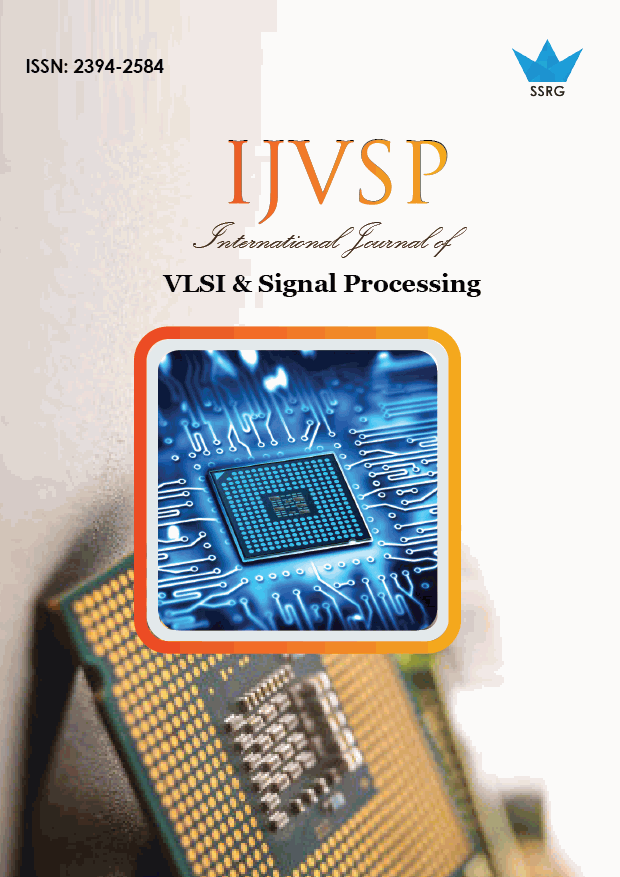A Novel Coplanar Based XOR/XNOR Structure For Designing QCA Circuits

| International Journal of VLSI & Signal Processing |
| © 2021 by SSRG - IJVSP Journal |
| Volume 8 Issue 1 |
| Year of Publication : 2021 |
| Authors : A. Kartheeswari, N.Priya, V.Sivani, V.Veeralakshmi, R.Geeta |
How to Cite?
A. Kartheeswari, N.Priya, V.Sivani, V.Veeralakshmi, R.Geeta, "A Novel Coplanar Based XOR/XNOR Structure For Designing QCA Circuits," SSRG International Journal of VLSI & Signal Processing, vol. 8, no. 1, pp. 21-23, 2021. Crossref, https://doi.org/10.14445/23942584/IJVSP-V8I1P105
Abstract:
Quantum-dot Cellular Automata (QCA) is nanotechnology which is an advance of VLSI research that challenges in contracting CMOS semiconductors mount. In this work, QCA gadgets and utilizations are utilized for those gadgets to fabricate a field-programmable gate array (FPGA). This FPGA has various arrange intelligent squares (CLBs) tiled together. In this work, a novel XOR/XNOR logic with two inputs, two fixed inputs, and one yield is developed. This system is planned in (QCA) nanotechnology for particular engineering configuration utilizing programmable gadgets which provides a minimum area and high performances.
Keywords:
XOR/XNOR, QCA Circuits
References:
[1] Javey, A., Guo, J., Wang, Q., Lundstrom, M., & Dai, H.M Ballistic carbon nanotube field-effect transistors. nature, 424(6949) (2003) 654-657.
[2] Lent, C. S., Tougaw, P. D., Porod, W., & Bernstein, G. H., Quantum cellular automata. Nanotechnology, 4(1) (1993) 49.
[3] Lent, C. S., Tougaw, P. D., & Porod, W. (1993). Bistable saturation in coupled quantum dots for quantum cellular automata, Applied Physics Letters, 62(7) 714-716.
[4] Snider, G. L., Orlov, A. O., Amlani, I., Zuo, X., Bernstein, G. H., Lent, C. S., & Porod, W., Quantum-dot cellular automata: Review and recent experiments, Journal of Applied Physics, 85(8) (1999) 4283-4285.
[5] Macucci, M., Gattobigio, M., Bonci, L., Iannaccone, G., Prins, F. E., Single, C., ... & Kern, D. P., A QCA cell in silicon-on-insulator technology: theory and experiment, Superlattices and microstructures, 34(3-6) (2003) 205-211.
[6] Roohi, A., Zand, R., Angizi, S., & DeMara, R. F., A parity-preserving reversible QCA gate with self-checking cascadable resiliency, IEEE Transactions on emerging topics in computing, 6(4) (2016) 450-459.
[7] Adelnia, Y., & Rezai, A., A novel adder circuit design in quantum-dot cellular automata technology, International Journal of Theoretical Physics, 58(1) (2019) 184-200.
[8] Balali, M., & Rezai, A., Design of low-complexity and high-speed coplanar four-bit ripple carry adder in QCA technology, International Journal of Theoretical Physics, 57(7) (2018) 1948-1960.
[9] Arani, I. E., & Rezai, A., Novel circuit design of serial-parallel multiplier in quantum-dot cellular automata technology, Journal of Computational Electronics, 17(4) (2018) 1771-1779.
[10] Vankamamidi, V., Ottavi, M., & Lombardi, F., Two-dimensional schemes for clocking/timing of QCA circuits, IEEE Transactions on Computer-Aided Design of Integrated Circuits and Systems, 27(1) (2007) 34-44.

 10.14445/23942584/IJVSP-V8I1P105
10.14445/23942584/IJVSP-V8I1P105